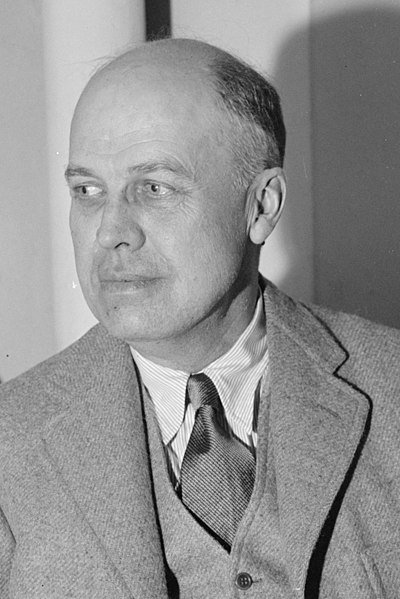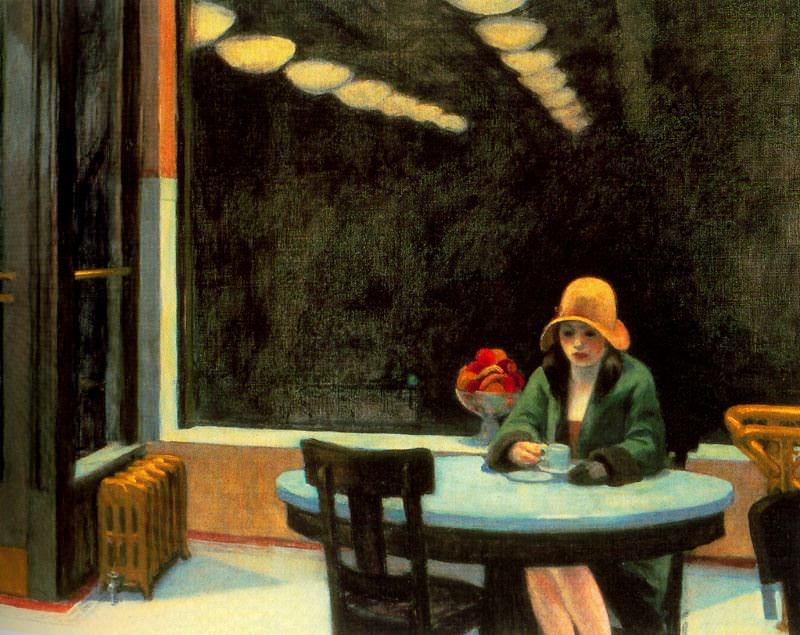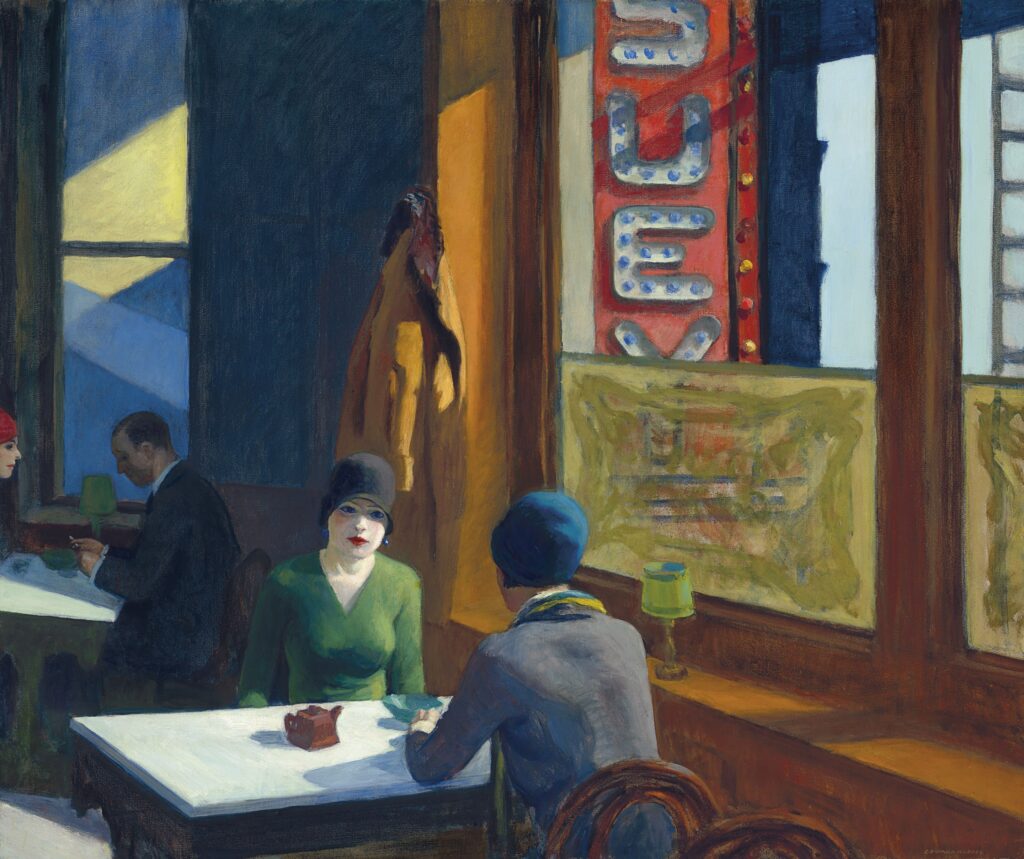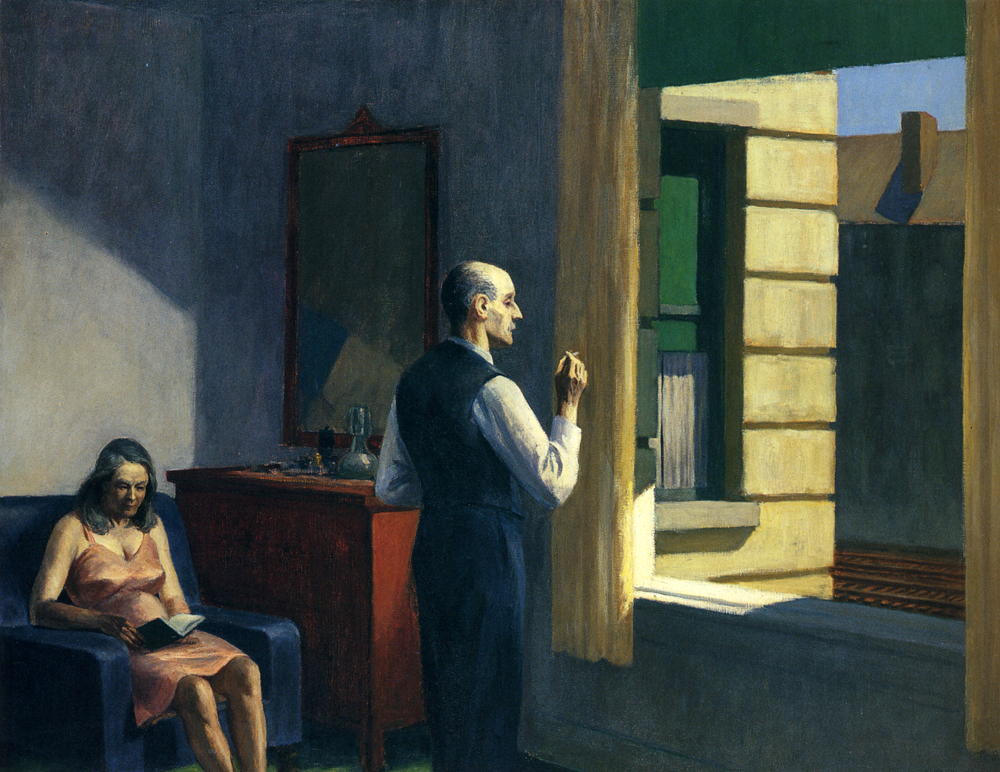
The man’s the work. Something doesn’t come out of nothing.”
Edward Hopper
The Identity of the Artist

Edward Hopper 1937: Wikimedia Commons
“I don’t know what my identity is. The critics give you an identity. And sometimes, even you give it a push.”
Edward Hopper
In the years since his death, critics have continually praised his art, calling him “the major twentieth-century American ‘realist’ and one of the giants of American painting.” ~ In fact, critics have long admired the realist character of Hopper’s work, and he himself accepted this praise.
Edward Hopper took a dim view of the wave of abstraction sweeping through the American art world in the 1940s and 1950s.
In 1952 Hopper joined a group of artists to protest the wholesale replacement of representational art by abstract art, especially at the Museum of Modern Art and the Whitney Museum of American Art.
The group published the short-lived Reality: A Journal of Artists’ Opinions , in which Hopper placed a statement describing modern art as little more than
“stimulating arrangements of color, form, and design,” and no substitute for the inner life of the human being, which he called “a vast and varied realm.
Edward Hopper , born in Nyack in 1882, remains one of the most important American painters. After studying to be an illustrator, he entered the famous New York School of Art, where he studied under the direction of Robert Henri, whose influence on Hopper s work was fundamental, as he was the one who encouraged Hopper to paint scenes from American life.
In his works, Hopper poetically expressed the solitude of man confronted to the American way of life as it developed in the 1920s. Inspired by the movies and particularly by the various camera angles and attitudes of characters, his paintings expose the alienation of mass culture.
Done in cold colours and inhabited by anonymous characters, Hopper s paintings also symbolically reflect the Great Depression.
Despite his numerous trips to Europe, he remained impervious to the major trends revolutionizing painting at the time, such as cubism or surrealism.
Dedicated to a very personal approach to his subjects, he modelled himself on classical painters, such as Rembrandt, Degas, or Daumier.
His paintings of gas stations, motels, and scenes from everyday life represent an aesthetic testimony to individualism, wide open spaces, and the fundamental values of the American nation.
He died in 1967, leaving behind a definitive imprint on American art .
The American Solitude

Automat-Edward Hopper-1927
Automats were self-service restaurants featuring giant, nickel-operated vending machines behind walls of glass and chrome doors. The places were clean and sanitary, and the nickel coffee almost legendary.
Jo and Edward Hopper knew all this, of course; as cost-conscious newlyweds in the 1920s, they were frequent visitors to the Automat in lower Manhattan. There were crowds and a hum of activity. This is not the case in Automat, however — Hopper spotlights a single late-night diner.
Scholar Gordon Theisen describes the scene:
“A young woman sits with downcast eyes at a round table … with barely enough enthusiasm for life to lift the cup of coffee she holds in her right hand near a small empty plate that may have held a roll or sandwich. Behind her a darkened plate-glass window reflects nothing of the Automat’s interior except for a line of lights along the ceiling. We see no crowds, only her, alone, in the center of this vast city. Why bother to remove her hat and coat? She has not.”

Chop Suey 1929 : Image Courtesy Wikimedia Commons
Here, Hopper features two women seated in a somewhat upscale and yet inexpensive second-floor Chinese restaurant, much like the one the Hoppers frequented in the early years of their marriage. By the late 1920s, chop suey had become all the rage in American cities.
The New York Times took notice: “Chop suey has been promoted to a prominent place on the midday menu of the metropolis…. It has become a staple. It is vigorously vieing with sandwiches and salads as the noontime nourishment of the young woman typists and telephonists.”
Hopper shows two of these young women in Chop Suey. They sit, somewhat stiffly, at a window table. The restaurant interior, shown in blacks and grays and browns, takes up the left half of the canvas. Outside the window that takes up the right half is a gaudy red and white sign, with SUEY spelled out in blue light bulbs. The light from the sign seeps into the dark restaurant interior and brightens thewindow frame, the cloche hats and sweaters of the young women, a coat hanging on a wall peg, and the restaurant’s white tabletops. Hopper’s skilled calibration of the elements of color, composition and light is nowhere more evident than in Chop Suey.
In 2008 Barney Ebsworth told art historian Rose Aidin how he felt, 34 years earlier, when he paid $180,000 to acquire Chop Suey: “I knew how great the picture was, and that the price was fair, I just didn’t think I should spend that much money on a picture … ten years ago I was offered $60 million for the painting. Today the market has gone crazy, and there are no great Hoppers left. So who knows what it’s worth—and I’m not selling anyway.”

Hotel Window-Edward Hopper 1955
Sitting in front of the huge window is another of Hopper’s solitary figures, a smartly dressed older woman.
“We cannot be sure,” writes scholar Rolf Renner, “whether the woman is actually looking at something outside the window or is simply lost in thought…. The street lighting is poor and we cannot make out any of the detail on the house fronts opposite. The inertia of the scene has infected the woman, it seems; her pose is tense and her coat seems unnaturally draped, as if frozen or billowed out by wind.”
Publishing magnate Malcolm Forbes bought Hotel Window in 1987 for $1.3 million. Actor/ comedian Steve Martin acquired the painting for $10 million in 1999.
Seven years later, he placed the oil on auction at Sotheby’s, New York where it sold for $26.9 million — a new record at the time for a Hopper painting at auction.
Sotheby’s catalog commented on the painting’s
“close connections to many elements of film noir ,” especially its “stark light, spare setting and lone female figure” in “an atmosphere of unease and emptiness.”

Hotel by a Railroad-Edward Hopper-1952
The sixty- something couple depicted in this painting share a cheap hotel room, yet neither acknowl- edges the other’s presence. Slouched in an arm- chair is a gray-haired woman in a pink slip, reading a book. A man fully dressed in trousers, shirt, and vest, cigarette in hand, stands at the window, taking in a bleak scene: a rear wall of the hotel, a set of railroad tracks, and a non- descript building across the way. Sunlight floods the room and bathes both figures, and yet there is no sense of warmth; the two seem worn out, tired of life and of each other.
James Mellow observed in 1971,
“ Hopper’s world, is a world of adults only, children never intrude upon the scene. He uses his figures sparingly: solitary men or women, manageable groups of three or four — never crowds. And there is, throughout his work, an ever-recurring couple — the bored young marrieds of ‘Room in New York,’ the boss and his secretary in ‘Office at Night,’ the seedy aging couple in ‘Hotel by a Railroad’— actors in a continuous private scenario that is drawn, one suspects, from Hopper’s own cloistral married life.”

New York Movie, 1939 by Edward Hopper
Hopper’s preparations for New York Movie —a ritual he once described as a long process of gestation in the mind and arising emotion — included 53 sketches of the interiors of movie houses, including the Strand, the Globe, the Republic and the Palace Theaters, located in the vicinity of Broadway and 47th Street.
Matters of composition, light, and color were high on his agenda. He creates a split- screen effect by running an ornate pillar and sidewall down the center of the canvas. At the left he shows an audience and partial view of the movie screen; at the right, an usherette standing in the hallway leading to the exit. The seating area is darkened; the hallway is bathed in light. Standing in that light, the blonde usherette becomes, in the words of art historian Avis Berman, “a shining beacon.” The viewer’s eye goes immediately to her blonde hair and blue uniform.
Hopper has created a mood. We look at the usherette, leaning against the wall, and want to know more. But this is, as art curator Pamela Koob points out, a dead end:
“To interpret the usherette’s solitude as loneliness may be to miss the point. Lacking expression, she defies anecdote. Perhaps she is merely savoring a chance to be alone and silent after dealing with the public … the ambiguity of the young woman seems quite deliberate and preserves the painting’s hold on the imagination.”
“And when the hour struck he was home, here in his big chair in big studio – and took one minute to die. No pain, no sound and eyes sere (sic) and even happy and very beautiful in death, like an El Greco….We were alone there in the late afternoon and he in his chair. No struggle, no pain, even gladly, and looked so beautiful.”
Excerpt From: Gerry Souter. “Edward Hopper”.
Josephine Nivison Hopper
Edward Hopper’s work is a national treasure, revived from time to time for future generations and is perpetually on display at the Whitney Museum of American Art.
Disclaimer: All recommendations are impartial and based on user experience, with no bias to the products or the brand. The products in this post may contain affiliate links.
[…] Dr. Carol S. Dweck A Photograph is not an Opinion. Or is it? Top Quotes of Susan Sontag American Silence: The Realism of Edward Hopper Dorothea Lange: The Photographer of People Imogen Cunningham: A Force to be Reckoned With […]